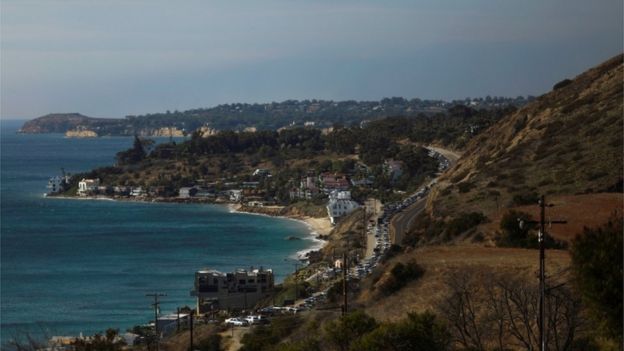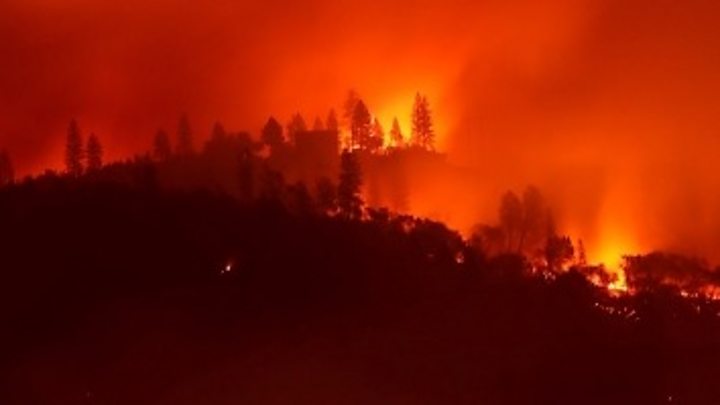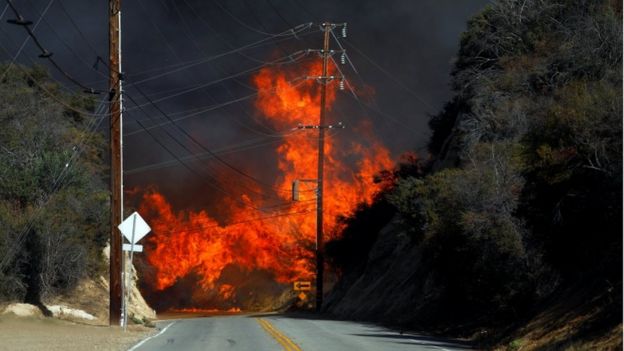California wildfires: Is smoke the most dangerous side-effect?
As firefighters work endlessly to control California’s raging fires, experts warn of long-term damage from wildfire smoke that could affect millions.
The fires have burned through over 200,000 acres, blanketing parts of California with clouds of thick smoke.
So what are the biggest impacts of wildfires and why is the western US state so susceptible to such deadly blazes?
How dangerous is wildfire smoke?
Wildfire smoke is comprised of water vapour, carbon monoxide and dioxide, chemicals and very small particulates.
Strong winds can carry harmful pollutants for hundreds of miles, and at current levels, the plumes can cause breathing difficulties even in healthy individuals.
The types of vegetation burning can affect how harmful the plumes are. Smoke from pine trees, for example, may be carcinogenic and eucalyptus is particularly toxic to humans.
One study by researchers from several US universities, including Yale and Harvard, estimates that more than 82 million people in the western US will suffer “significant” health consequences from wildfire smoke in the next 20 years.
And those consequences are not just respiratory-related – wildfire smoke can also affect those with cardiovascular diseases, according to the National Institutes of Health (NIH).
Those with pre-existing chronic conditions like asthma or heart conditions, as well as children, pregnant women and the elderly are most susceptible to negative health effects.
Masks can help mitigate some of the dangers, but only certain kinds can keep out all the toxins, and some California communities are already experiencing a mask shortage, Kaiser Health reported.


What’s the best way to escape a wildfire?
Once evacuation orders are issued by local law enforcement, residents generally have hours to leave, Kathleen Schori, information officer for the California Department of Forestry and Fire Protection (Cal Fire) told the BBC.
“But in those initial stages of a fire, you may have minutes,” she added.
Fleeing in a vehicle is ideal as most wildfires cannot be outrun. But the Camp Fire’s especially rapid spread, fuelled by high winds, made the situation even more dangerous.
“This fire moved so fast – I don’t think anybody did anything wrong,” Ms Schori says when asked whether those forced to abandon vehicles and escape on foot could have acted differently.
“During the initial phases, it was burning 80 miles in an hour.”
She stressed the importance of following evacuation orders immediately, especially with fast-moving blazes.
“If you don’t evacuate and it becomes a rescue situation, then our firefighters are taken away from the firefight and moved to the rescue.”


How do you fight a wildfire?
Sometimes, you do fight fire with fire.
In addition to old-fashioned water and flame retardant (delivered from ground-level and above the flames by aircraft), sometimes firefighters have to burn more to quell the flames.
Intentionally burning areas around a wildfire can help starve the blaze and control its direction. Clearing out brush and flammable material from an area to create “firebreaks” is another way to achieve the same.
“Ninety-eight percent of fires are small and/or suppressed quickly,” Prof David Peterson of the University of Washington, a former senior researcher with the US Forest Service told the BBC.
“The other 2% are very challenging when they get large, and are almost impossible to put out, at least until it rains.”
Ms Schori of Cal Fire said that with wind-driven blazes like the Camp Fire, officials often have no choice but to wait for conditions to improve.
“There are never enough firefighters to combat a fire that’s moving as fast as this was moving,” she says.
“You have to deploy your resources on each side [of the fire] and continue to construct lines. And when that wind stops, then you can safely get in front it.”


How do wildfires start?
Officials define wildfires, or wildland fires, as any fire occurring on undeveloped land. Forest fires are uncontrolled wildfires burning in lands covered at least in part by timber or flammable vegetation.
In nature, two things can spark wildfires: lava and lightning.
According to the National Park Service, 90% of wildfires in the US are caused by humans – whether by unattended campfires, burning debris, cigarettes, or arson.
About 2% of California’s 2,816 wildfires in 2016 were caused by lightning, according to data from Cal Fire. The majority could be attributed to humans, though only 8% were caused by arson.
Determining the cause of a wildfire can be a painstaking process.
Investigators search for a fire’s point of origin by looking at how the fire spread – at the start, flames grow outward in a circle unless wind or terrain affects it otherwise,according to National Wildfire Coordinating Group’s handbook.
From there, officials comb through the area to determine if the blaze was of natural or human origin, looking for pieces of evidence like lightning scars on trees, campfire kindling, or cigarette butts.


Why are California fires so devastating?
According to Prof Peterson, fires in the region have not necessarily increased in frequency in the last 100 years – but the area affected has.
“The area burned annually has been higher during the past 30 years or so,” he told the BBC. “It should be noted that 2% of fires burn 98% of the area.”
In California, recent years have seen a combination of extremely high temperatures, strong winds, a long drought, and population growth causing lethal, fast-moving blazes.
Last year, the state had over 9,500 wildfires that burned over a million acres,according to the National Interagency Fire Center, and had the highest number of homes and buildings lost in one state.
And straying away from natural burning cycles has also contributed to the lethality of recent fires, Prof Peterson says.
Keeping fires from starting in Western forests has caused fuel to accumulate “far beyond” historical levels.
“Therefore, when fires occur they can burn hotter,” he says. “These high-intensity fires can cause rapid and in some cases long-term changes in vegetation, making it more difficult for the ecosystem to recover.”


What about climate change?
Prof Peterson says there is no hard evidence that climate change has affected US wildfires – yet.
“We expect that there will be significant effects in future decades as the climate continues to warm,” he told the BBC.
A warming climate, Prof Peterson explained, would increase the duration of the fire season, and more droughts would in turn create more wildfire fuel.
Globally, the length of the wildfire season has already increased by nearly 19% between 1978 and 2013.
“By around 2050, fires may burn two to three times more area than they have historically.”
How do homeowners pay for the damage?
According to 2017 data from Verisk Analytics, 4.5 million US homes were in areas of high or extreme wildfire risk – and over 2 million of those homes were in California.
Damage caused by wildfires has cost $5.1bn in the last decade, Verisk found.
In California, homeowners who do not qualify for private insurance coverage can opt into a statewide pool, called the Fair Access to Insurance Requirements (FAIR) plan.
FAIR is comprised of all property and casualty insurers in California and is not run by a state agency.






